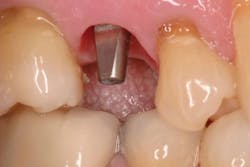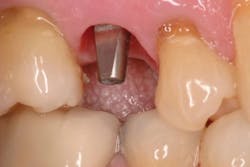Oral cancer screening: Where do we go from here?
by Kevin D. Huff, DDS, MAGD
For more on this topic, go to www.dentaleconomics.com and search using the following key words: oral cancer, oral cancer screening, adjunctive oral mucosal screening technologies, dysplasia, false positive, protocols, biopsy, Dr. Kevin D. Huff.
Henry Ford once made the observation, “Thinking is the hardest work there is, which is the probable reason so few of us engage in it.” Within the past few years, several systems have come to the forefront of the marketplace that offer assistance in the task of oral mucosal screening. Adjunctive screening systems are generally easy to use by both dentists and hygienists, but interpreting observations requires thought, learning, and a thorough understanding of anatomy. Implementing adjunctive screening technologies — or making the choice not to implement them — requires appropriate education and an understanding of currently available literature, which is comprised of case studies, criticisms, and praises for adjunctive oral mucosal screening technologies.
Adjunctive mucosal screening systems are not diagnostic. They were designed for the purpose of helping to identify very early abnormal-appearing mucosal lesions, and to assist clinicians in performing better conventional oral cancer screening examinations. Unfortunately, confusing marketing language and strategies by nearly every adjunctive screening device has fueled the misconception that these systems may “find oral cancer.” This is not unlike the misconception that digital dental radiographs or screening lasers “find caries.”
Technology only enables clinicians to gain more information in order to determine whether their observations are normal or abnormal in appearance. Diagnosis requires interpretation of data, and therefore no screening device can “find” lesions. It is generally accepted that the only way to diagnose any mucosal lesion definitively is by histological analysis via a surgical biopsy. None of the currently available screening systems, visual or cytological, have ever claimed to be diagnostic.
Currently, there are four categories of adjunctive mucosal screening systems: direct tissue fluorescence visualization (DTFV), reflectance, cytology, and salivary. There are two types of visual adjunctive screening systems that do not involve collecting tissue fluids. DTFV uses specific wavelengths of light that are reflected by metabolites in the Krebs cycle of cells — loss of fluorescence indicates an increased level of cellular turnover. Reflectance systems amplify the ability to see white (hyperkeratotic) lesions. Both DTFV and reflectance are only visual screening tools.
Systems requiring collection of samples for screening include cytology and saliva sampling. Cytology is utilized by several systems, usually employing some type of brush collection of cells. Cytology helps to identify atypical or abnormal cells that may be present in a sample. Ploidy, or the amount of chromosomal DNA in a sample, may also be obtained from cytology, which may indicate high-risk patterns of cellular reproduction. Analysis of saliva for the presence of human papillomavirus (HPV) has only recently been introduced, which may be helpful in establishing appropriate follow-up protocols when early lesions are discovered.
Certain varieties of HPV, predominantly type 16 and possibly a few others, are revolutionizing the way we identify risk groups for oral cancer. However, we are uncomfortable with this because we have inadequate training about how to appropriately approach the topic of oral sex practices with our patients, the possible legal and social implications of such discussions, and how to appropriately inform our patients about abnormal early findings that may be controversial without causing unnecessary psychological harm.
Those who oppose the use of adjunctive screening devices often argue that they are prone to false positive results that may lead to overtreatment. However, the term false positive must be defined; it is relative to what is being tested. A false positive occurs when a sample is assumed to be one thing, but when tested it turns out to be something else.
For example, if a dentist finds an early lesion and thinks that it is cancer, but histological analysis reveals that it is normal tissue or even dysplasia without carcinogenesis, then that would be a false positive. However, if a lesion is found and clinically interpreted as “something abnormal,” and it turns out to be anything that is not normal tissue, this is a true positive result. Incidentally, a false negative occurs when lesions are “watched,” thought to be “normal,” but are later determined to be carcinoma. False negatives have devastating consequences, both physically for the patient and medicolegally for the clinician.
Unfortunately, the following scenario is common in the practice today. Let’s use the example of Dr. I. B. Proactive, a general dentist. Dr. Proactive discovers with direct tissue fluorescence imaging and conventional oral examination a subtle, flat, erythematous lesion at the back of the oropharynx that is not painful but that hasn’t healed in several weeks.
There is nothing that indicates trauma in the patient’s history. The patient is referred to a specialist for evaluation. The specialist may not clearly see the lesion discovered by Dr. Proactive, or from observation alone may make the assumption that it is simply normal variation in appearance. The specialist may or may not choose to biopsy the lesion.
Fig. 1 — A diffuse erythematous lesion appears innocuous but was diagnosed as moderate dysplasia upon histological analysis of surgical biopsy.
However, let’s assume that the specialist is philosophically more conservative. He chooses to monitor the patient for three months to see if the lesion disappears. The patient now notices the lesion and is concerned. So the patient decides to go to another specialist who opts to biopsy the lesion immediately. The biopsy report reveals severe epithelial dysplasia (Figs. 1 and 2).
Fig. 2 — Direct tissue fluorescence visualization of the lesion in Fig. 1. Note loss of fluorescence in the area of confirmed dysplasia.
The first specialist erred on the side of having a false negative; the second specialist erred on the side of making a false positive assumption. Even though the second specialist’s approach may have seemed to be more aggressive initially, it ultimately turned out to be the most conservative approach to diagnosis and management of this lesion.
Quite frankly, visual mucosal screening aids are like flashlights. If I had to walk across my backyard at night, knowing that there is a large hole into which I might fall, I have two choices: I can make the trek in the dark, or I can use a flashlight. Of course, any sane individual would want the flashlight. However, to use the flashlight I must know how to interpret the shadows that the terrain casts under flashlight illumination, which probably appear different in daylight.
There are several types of courses available on how to use adjunctive screening technologies. For example, I offer lecture and workshop courses on how to use each currently available technology, and then show how general dentists may perform simple biopsy procedures.
Other types of oral cancer screening courses are also available, ranging from introductory short lecture programs to extensive pathology review courses. I would encourage users of adjunctive screening devices to take courses from a variety of speakers because each of us has a unique approach and rationale for implementation.
Several years ago, pioneers in gynecology were strongly criticized for claiming that Pap smears could be used routinely for early detection of cervical cancer. Today, they are used routinely, clear protocols exist for abnormal findings, and lives are being saved through early detection.
Dentistry can learn from the history of gynecological medicine. Progressive thinking led to drastically improved longevity and quality of life for women who otherwise may have died at an early age due to cervical cancer.
I agree with those who would argue that oral cancer and severe dysplasia should be able to be discovered by properly conducted conventional oral exams. However, performing conventional oral exams has not improved oral cancer survival rates over the past four decades. As the saying goes, “If you always do what you always did, you’ll always get what you always got.” We need to be proactive in our fight against oral cancer. Adjunctive screening devices, despite their potential flaws, encourage clinicians to perform better conventional oral exams and give us the opportunity to discuss potential high-risk behaviors with our patients.
I believe that the adjunctive screening systems available today will evolve. As in all industries, good companies with good products will survive and develop better products, and others will disappear from the marketplace. However, I believe that we will see a continued push for better adjunctive screening systems, as has occurred in medicine.
Further research is always necessary, and debate is healthy. Protocols need to be refined and then challenged and tested, which is good science. What we know today is not what we will know tomorrow, but I hope that our profession never stops trying to save lives through early intervention.
Kevin D. Huff, DDS, MAGD, is a practicing general dentist in rural Ohio, a private researcher, author, and dental educator. A clinical instructor at the Case School of Dental Medicine, he lectures nationally about oral cancer screening and biopsy techniques. Contact him at [email protected], or visit www.doctorhuff.net.

